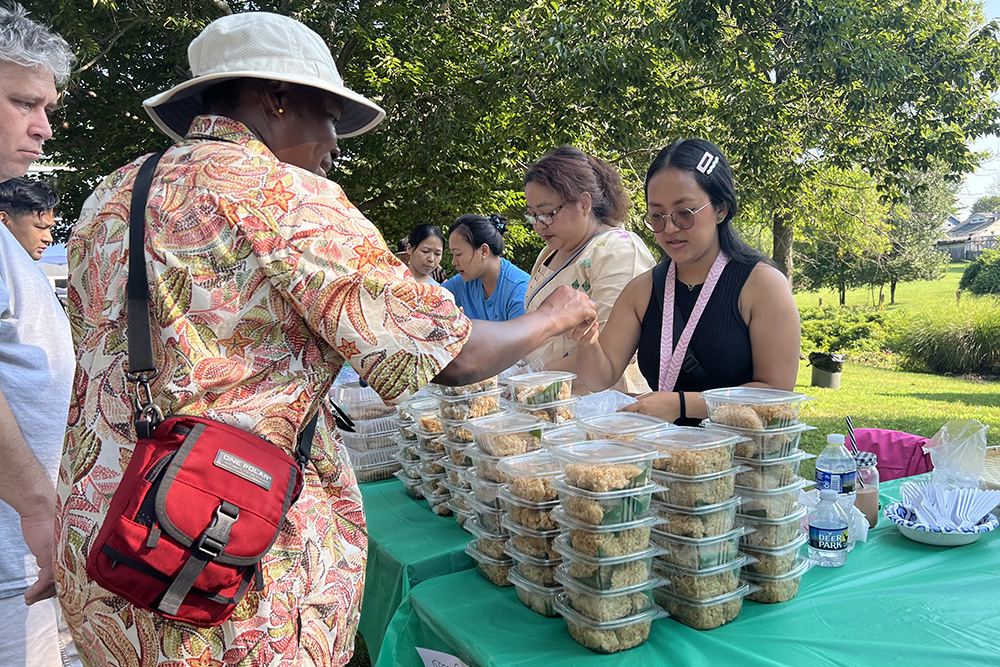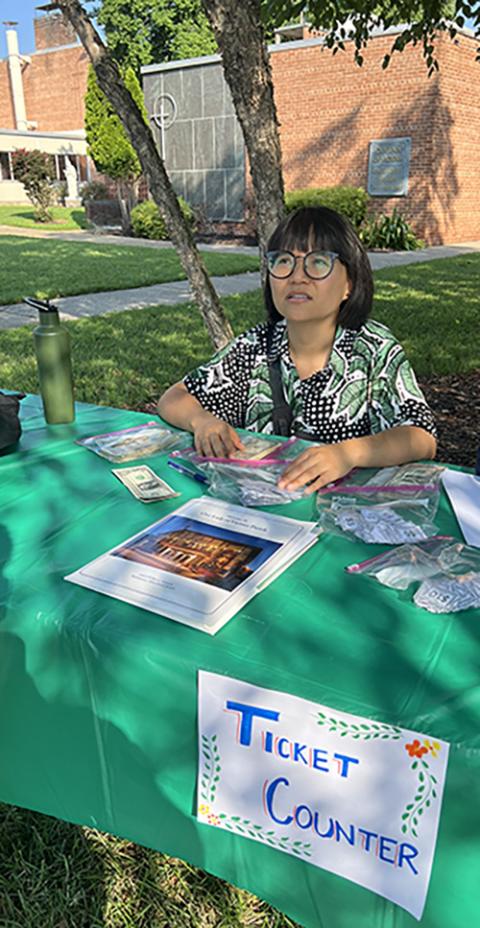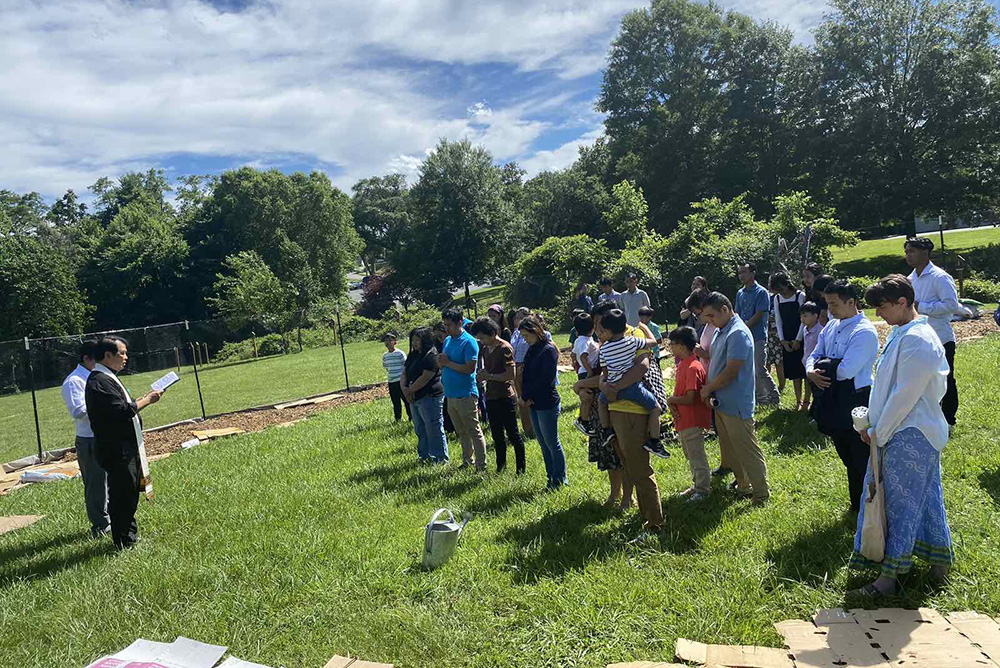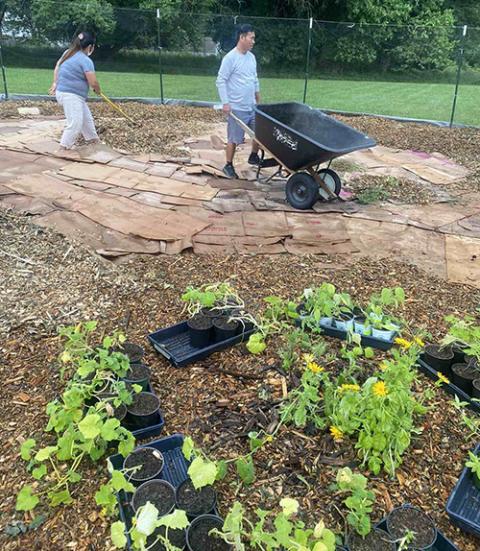
New and longtime parishioners share food at the first Burmese food fair at Our Lady of Victory parish in Baltimore. Burmese parishioners made dishes such as coconut sticky rice for the fundraiser. Many Burmese refugees have found a home at the parish after escaping persecution in Myanmar. (Matt Palmer)
In Baltimore City, countless stories are told about European immigrant families who arrived in the 19th and 20th centuries with only their Catholic faith. They left discrimination and persecution behind and encountered new, but similar, challenges as they re-established their lives in the United States.
And they built churches that became the bedrock of the Archdiocese of Baltimore, often referred to as the Premier See because the diocese was the first in the nation.
Today, a group of Burmese refugees who are credited with helping save Our Lady of Victory parish from potential closure this past summer are planting seeds for what's next.
Advertisement
Five Burmese families have joined long-standing parishioners in starting a 3,000-square-foot community garden to yield produce for the parish's food pantry which serves 50-60 people each Saturday.
"The parishioners were inspired by Pope Francis' 2015 second encyclical, Laudato Si', calling for the care of our common home, resonating with St. Francis of Assisi," said parishioner and Burmese refugee Joan Huai. She is one of nearly 200 and growing people who fled their country's junta persecution of Catholics.
Just four months ago, Our Lady of Victory was one of dozens of parishes in and around the city that were proposed to close as part of the archdiocese's "Seek the City to Come" initiative, an answer to dwindling Mass attendance in Baltimore. The archdiocese's largest parishes are in Maryland counties 20 minutes away. Our Lady of Victory has about 500 parishioners and is just across the Baltimore County line in a town called Arbutus. At 13 acres, it is a green oasis in a neighborhood where urban and suburban hastily converge.
When Our Lady of Victory corporator Kathy Hendry arrived at the parish to worship in 1978, it was a mostly white, blue-collar Catholic community. Bull roasts, bingo and holiday gatherings were beloved traditions and the parish school thrived until the 2000s. The archdiocese closed the school in 2021 following the COVID-19 pandemic as years of enrollment dips proved too much to overcome.

Joan Huai welcomes guests at the first Burmese food fair at Our Lady of Victory parish in Baltimore. Huai and her fellow Burmese parishioners, many of them refugees, helped save the parish this year and have started a 3,000-square-foot community garden there. (Matt Palmer)
When the diocese announced proposed parish closings during April 13 Masses, Our Lady of Victory was on the list. Lifelong and new parishioners remained in their pews dabbing away tears. Others were bewildered or angry.
"OLV is a multi-generational and multi-national parish and that's what makes us so special and will hopefully sustain us into the future," Hendry said.
Soon, staff and parishioners redirected their energy to messaging that addressed concerns of the archdiocese while sharing the parish's efforts to welcome others into the community.
"Over the years, the parish has become very diverse, with people of all colors and ages," Hendry said. "This is what makes for a vibrant community and helps all of us understand people from different backgrounds."
For the Burmese refugees, the parish grounds are indeed a refuge, something Huai was able to articulate on April 30 during an archdiocesan listening session and with officials privately.
Speaking at the Cathedral of Mary Our Queen, Huai shared how many were resettled in nearby apartment complexes by organizations such as Catholic Charities. They lived within walking distance of the parish, did not drive or speak English. If Our Lady of Victory were to close, access to a Mass would have gone down dramatically.
The parish was their sense of belonging in a country they were still getting to know.
The Our Lady of Victory community arrived at the Cathedral with three full buses, including one with many from Myanmar. The parishioners donned blue T-shirts bearing the parish's name.
"While most of our arguments to keep OLV open did not seem compelling to the leadership team, it was when Joan Huai spoke about the Burmese story that seemed to catch their attention," Hendry said.
The archdiocesan newspaper, The Catholic Review, profiled the growing Burmese population nearly a decade ago. At the time, there were about 119 Burmese adults and children as parishioners.
"When the Burmese people first started to attend OLV many years ago, it was evident that they were a great addition to our parish," Hendry said. "Burmese families attended and participated in the Mass every week even though many couldn't speak or understand English."

Fr. Paul HtunKhine blesses a community garden begun by Our Lady of Victory parishioners in Baltimore this summer. The garden's aim is to provide for the campus’ busy food pantry. (Courtesy of Joan Huai)
A visiting priest from Myanmar, Fr. Paul HtunKhine, celebrates Mass in Burmese in the church space and a chapel inside the rectory. The number of Burmese parishioners continues to rise, as the regular cries of babies and chatter of toddlers is a testament.
Huai was resettled in the U.S., along with her brother and cousins, by Catholic Charities when she was 11-years-old.
A 2021 graduate of Georgetown University's Walsh School of Foreign Service, she joined Our Lady of Victory in recent years. Passionate about community organization, Huai has made a difference in a dizzying amount of time and serves as a member of the parish council.
Before arriving at the parish, Huai said she was like many people in their 20s, going through a faith-questioning period. Discovering she could serve as a translator and advocate for fellow parishioners helped her feel more secure in the church community again.
On May 22, the parish found out it would remain open. The archdiocese decided the existing 61 parishes would be cut down to 23 with 30 worship sites.
Given the space to dream now, Huai wants to connect longtime parishioners with the Burmese children of the parish for school tutoring sessions since many of the parents speak little to no English.
"Here, it's a mysterious way of how God works after 'Seek the City,' " Huai said. "Something in me felt like I hadn't been doing enough. Now I feel like I can do this with everyone else together."
Our Lady of Victory's future is currently being crafted. A new pastor, Fr. Michael Murphy, arrived in July while continuing as pastor of nearby St. Joseph's Monastery. At the end of the year, St. Joseph will become a worship site, while the Our Lady of Victory campus will serve as the central hub in Southwest Baltimore. City parishes St. Benedict and Transfiguration are scheduled to close at the end of the year and parishioners will be encouraged to join Our Lady of Victory.
Signs of that collaboration are happening already, as St. Joseph's and Our Lady of Victory are sharing religious education classes starting in September.
On Aug. 9 of this year, Burmese parishioners held their first fundraising food fair at Our Lady of Victory, a nearly all-day affair that brought in $7,156. Smells of noodles, pork, chicken, fried bread, spices and more filled the air. Parishioners of all backgrounds attended.
"It was wonderful to see folks of different ethnicity, race, religious backgrounds coming to enjoy and support the fair," Huai said.
Just a few hundred feet from the fair, the community garden could be seen in the background.
The idea of a garden on campus was discussed for many years and often hit a logistical stall. During a parish council meeting earlier this year, Huai said the Burmese parishioners wanted to help, as many didn't have land at their apartments for gardening.
Soon she was meeting English-speaking parishioners such as Andrea Craig and Kelly Neale, who also serves as volunteer coordinator at Little Portion Farm, a ministry of the Conventual Franciscan Friars, in nearby Ellicott City.
Neale helped provide much of the financial support and knowledge needed to start the community garden. Parishioners have spent evenings watering and tending to the garden, which has tomatoes, eggplant, peppers, okra, squash, basil and other herbs, long beans, lettuce, chard, peas, peanuts, sunflowers, zinnias, marigolds and more.

Sunflowers bloom alongside produce at the Our Lady of Victory community garden in Baltimore. The aim of the garden is to provide food for the parish’s bustling food pantry that serves people in Baltimore County and City. (Matt Palmer)
"We hope the graces we receive in this endeavor will flow outwards to the general community, at first practically by donating a portion of our harvest to the OLV food pantry," Neale said. "Eventually, we would like it to be a welcoming outdoor gathering space that is pleasant to enjoy and also produces food."
Craig, a longtime parishioner, spoke at parish Masses earlier this year and made an impassioned plea for volunteers for the parish's ministries. She said she's been "overwhelmed" by the response by Burmese parishioners.
"Using inclusive language helps. It's our church," Huai said. "We all have a responsibility."
"[The Burmese parishioners] bring their own knowledge of gardening and still are willing to try new ways of doing things," Neale said. "Their faith is strong, their community is strong, and they are strong and beautiful people."
Huai once again stressed inclusive collaboration as the key to the garden's future.
"The next goal of the garden is to expand and involve more parishioners — not just Burmese folks — to create a much more vibrant community of gardeners," Huai said.
Editor's Note: This story was updated to correct the spelling of Joan Huai's name.









